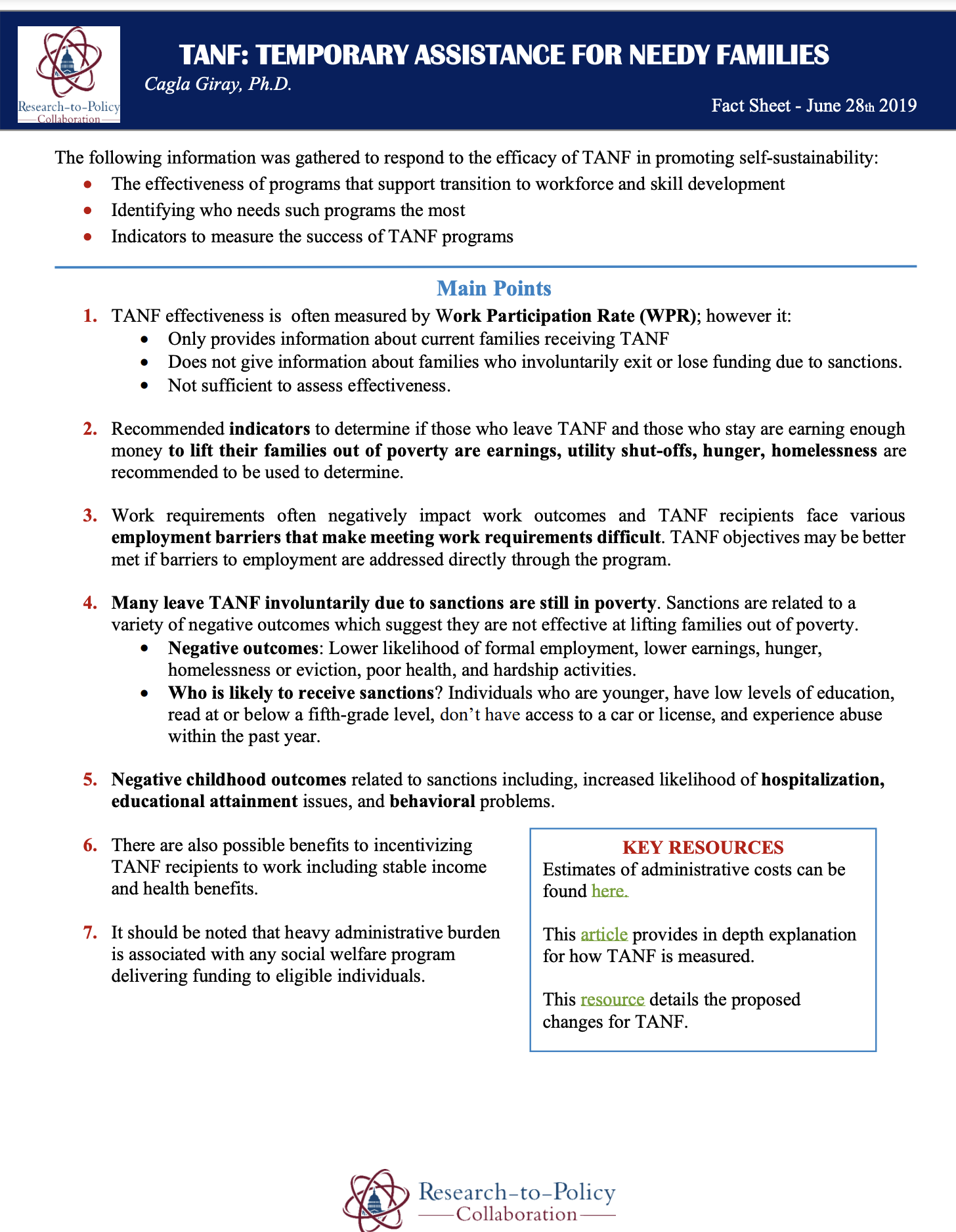
The following information was gathered to respond to the efficacy of TANF in promoting self-sustainability:
- The effectiveness of programs that support transition to workforce and skill development
- Identifying who needs such programs the most
- Indicators to measure the success of TANF programs
Main Points
- TANF effectiveness is often measured by Work Participation Rate (WPR); however it:
- Only provides information about current families receiving TANF
- Does not give information about families who involuntarily exit or lose funding due to sanctions.
- Not sufficient to assess effectiveness.
- Recommended indicators to determine if those who leave TANF and those who stay are earning enough money to lift their families out of poverty are earnings, utility shut-offs, hunger, homelessness are recommended to be used to determine.
- Work requirements often negatively impact work outcomes and TANF recipients face various employment barriers that make meeting work requirements difficult. TANF objectives may be better met if barriers to employment are addressed directly through the program.
- Many leave TANF involuntarily due to sanctions are still in poverty. Sanctions are related to a variety of negative outcomes which suggest they are not effective at lifting families out of poverty.
- Negative outcomes: Lower likelihood of formal employment, lower earnings, hunger, homelessness or eviction, poor health, and hardship activities.
- Who is likely to receive sanctions? Individuals who are younger, have low levels of education, read at or below a fifth-grade level, don’t have access to a car or license, and experience abuse within the past year.
- Negative childhood outcomes related to sanctions including, increased likelihood of hospitalization, educational attainment issues, and behavioral problems.
- There are also possible benefits to incentivizing TANF recipients to work including stable income and health benefits.
- It should be noted that heavy administrative burden is associated with any social welfare program delivering funding to eligible individuals.
Key Resources
The Research-to-Policy Collaboration (RPC) works to bring together research professionals and public officials to support evidence-based policy. Please visit their website to learn more.
Key Information
RPC Website
Research-to-Policy Collaboration
More RPC Resources
RPC Resources
Publication DateJune 28, 2019
Topic Area(s)Social Services
Resource TypeWritten Briefs
Share This Page
The following information was gathered to respond to the efficacy of TANF in promoting self-sustainability:
- The effectiveness of programs that support transition to workforce and skill development
- Identifying who needs such programs the most
- Indicators to measure the success of TANF programs
Main Points
- TANF effectiveness is often measured by Work Participation Rate (WPR); however it:
- Only provides information about current families receiving TANF
- Does not give information about families who involuntarily exit or lose funding due to sanctions.
- Not sufficient to assess effectiveness.
- Recommended indicators to determine if those who leave TANF and those who stay are earning enough money to lift their families out of poverty are earnings, utility shut-offs, hunger, homelessness are recommended to be used to determine.
- Work requirements often negatively impact work outcomes and TANF recipients face various employment barriers that make meeting work requirements difficult. TANF objectives may be better met if barriers to employment are addressed directly through the program.
- Many leave TANF involuntarily due to sanctions are still in poverty. Sanctions are related to a variety of negative outcomes which suggest they are not effective at lifting families out of poverty.
- Negative outcomes: Lower likelihood of formal employment, lower earnings, hunger, homelessness or eviction, poor health, and hardship activities.
- Who is likely to receive sanctions? Individuals who are younger, have low levels of education, read at or below a fifth-grade level, don’t have access to a car or license, and experience abuse within the past year.
- Negative childhood outcomes related to sanctions including, increased likelihood of hospitalization, educational attainment issues, and behavioral problems.
- There are also possible benefits to incentivizing TANF recipients to work including stable income and health benefits.
- It should be noted that heavy administrative burden is associated with any social welfare program delivering funding to eligible individuals.
Key Resources
The Research-to-Policy Collaboration (RPC) works to bring together research professionals and public officials to support evidence-based policy. Please visit their website to learn more.

Key Information
RPC Website
Research-to-Policy Collaboration
More RPC Resources
RPC Resources
Publication DateJune 28, 2019
Topic Area(s)Social Services
Resource TypeWritten Briefs
Share This Page
LET’S STAY IN TOUCH
Join the Evidence-to-Impact Mailing List
Keep up to date with the latest resources, events, and news from the EIC.




